Astronomy 10: Lecture 15
Lecture 15
Monday, June 24th 2002. Reading: Cosmic Perspective Chapters S3 & 17
Relativity
Recall that with Special Relativity we had two basic rules from which all the strange effects of relativity resulted:
- The laws of physics are the same for everyone. All free floating frames of reference are indistinguishable from one another.
- The speed of light is a constant, and measured to be the same for everyone despite their relative velocities.
General Relativity
By 1915 Einstein had argued that there should be a sense of relativity that included frames of reference that are accelerating. Hence he was able to include gravity in his new theory.
The Equivalence Principle
In special relativity we saw that when two people move relative with respect to one another at constant velocity they can each consider themselves to be at rest with equal validity.
When accelerations are involved the situation takes on another face altogether.
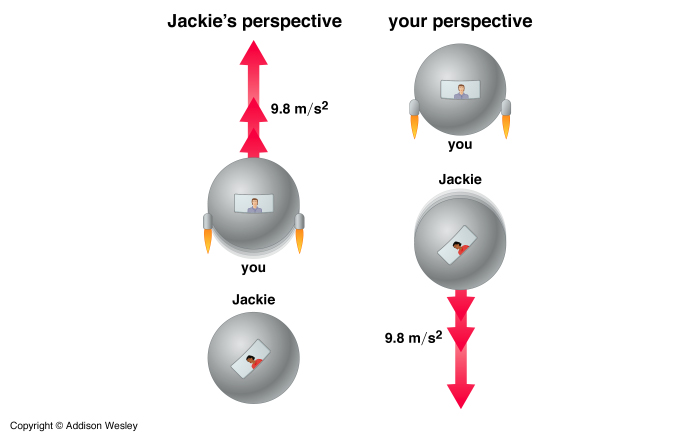 Imagine that You and Jackie are floating around in space and You suddenly fire your engines and produce an acceleration up at 9.8 m/s/s.
Imagine that You and Jackie are floating around in space and You suddenly fire your engines and produce an acceleration up at 9.8 m/s/s.
You cannot consider yourself to be at rest while Jackie accelerates away from You. You feel weight and can see that Jackie is floating freely. You should also be floating free if You are not in motion and she should feel weight if she were accelerating.
It would certainly seem that there is no relativity here. But Einstein thought that the laws of physics should be the same for all observers no matter if they are feeling forces or not.
|
|
In 1907 Einstein came upon a great revelation. Whenever you feel weight (as opposed to weightlessness), you can equaly well attribute it to the effects of either acceleration or gravity. This idea is called the equivalence prinicple: The effects of gravity are exactly equivalent to the effects of acceleration.
|
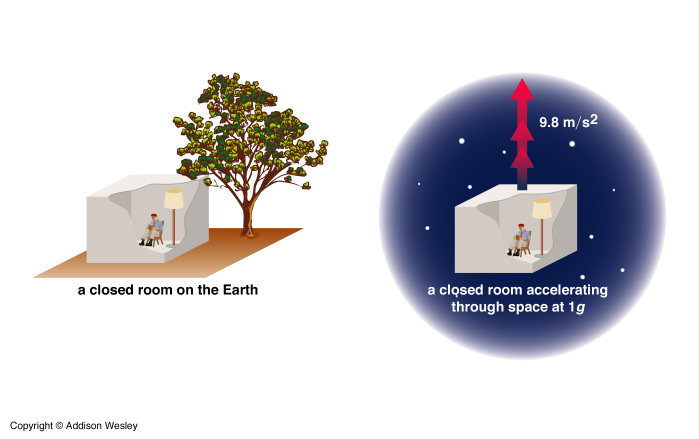 Imagine that you are sitting in a closed room with the shades drawn. If your room was moved to outerspace and accelerated at a rate of 9.8 m/s/s you would not notice anything different.
Imagine that you are sitting in a closed room with the shades drawn. If your room was moved to outerspace and accelerated at a rate of 9.8 m/s/s you would not notice anything different.
If you did physics experiments by dropping balls and so forth you would yeild the same results as you did when the room was on Earth.
|
 Return to You and Jackie. You think that you must be accelerating upward. But You could equivalently say that your ship is at rest on the Earth's surface, perched on a cliff say, and that is why you feel weight. The reason You see Jackie freely floating is that she is falling toward the Earth. She is in freefall just like space shuttle astronauts.
Return to You and Jackie. You think that you must be accelerating upward. But You could equivalently say that your ship is at rest on the Earth's surface, perched on a cliff say, and that is why you feel weight. The reason You see Jackie freely floating is that she is falling toward the Earth. She is in freefall just like space shuttle astronauts.
The physics of the two situations are exactly equivalent. So the equivalence principle allows us to state that all motion is relative. This will lead us to some startling discoveries about the nature of space and time!
Some alternative phrasing of the Equivalence Principle:
- All accelerating frames are indistiguishable. Acceleration due to gravity is equivalent to acceleration due to other forces: gravitational mass is the same as inertial mass.
- Freely Floating Frames are equivalent to Freely Falling Frames.
|
Spacetime
The physics of the two situations above may be the same, but they sure don't look the same. Why is that? General Relativity would say that it's because we are not looking at the whole picture. We are looking at the 3-dimensional picture and ignoring the time aspect. But what we have discovered thus far with relativity is that space and time are interconnected and bound up into a 4-dimensional spacetime. We cannot see the full 4-dimensional events only their projections into 3-D. So, we must learn to "look" at the full 4-D spacetime.
Spacetime is a 4-D continuum in which the independent directions of motion are up-down, forward-back, left-right, and through time. Events occur in 3 spatial dimensions and at one point in time. In the whole continuum objects are streched out in time as well. If you were a 4-D being in this continuum you could look through time as easily as you look to your right.
In 3-D we can only see projections of 4-D. And the projections can look very different from different point of view. As an example. Imagine a book. Everyone can come measure it and agree on its dimensions. But it can be viewed in projection into 2-D as very many things.
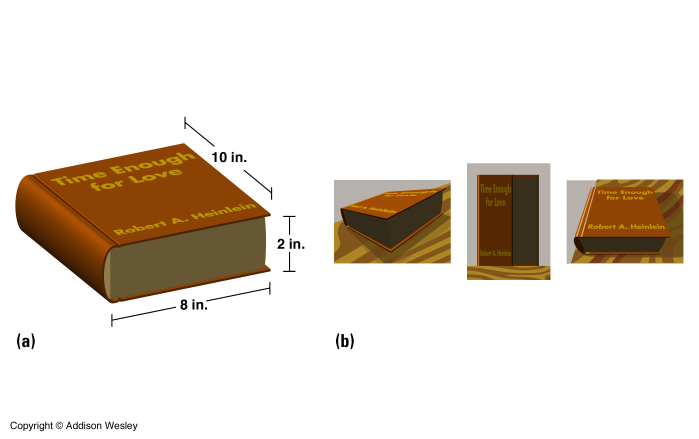
So the heart of relativity is then that different observers are seeing different projections of 4-D spacetime into 3-D space.
"Space is different for different observers. Time is different for different observers. Spacetime is the same for everyone." - Taylor, Wheeler, Freeman.
Curvature of Spacetime
We shall discover that mass/energy causes spacetime around it to curve, and that gravity is the result of an object's path through curved spacetime. But whatever does it mean for spacetime to be curved?
We must look at lower dimensional analogies to get a feel for what this means since it is not only impossible to imagine 4-D objects, but 4-D space curved into some 5th dimension (a hyperspace).
Consider good old 2-D geometry.
In a flat space with no curvature (a plane):
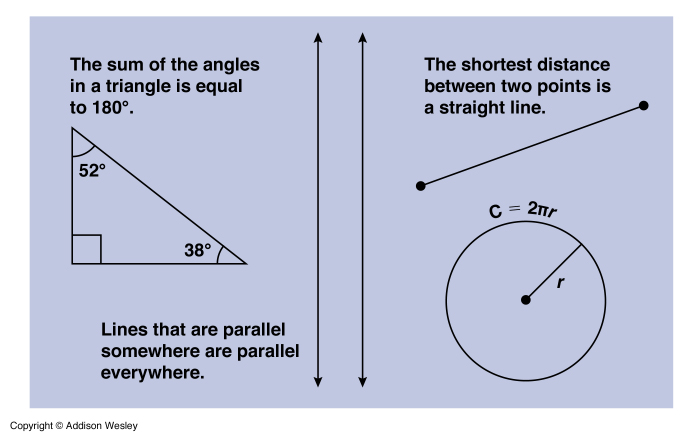
But in a space which is positively curved (like a sphere):

And in a space that is negatively curved (like a saddle):
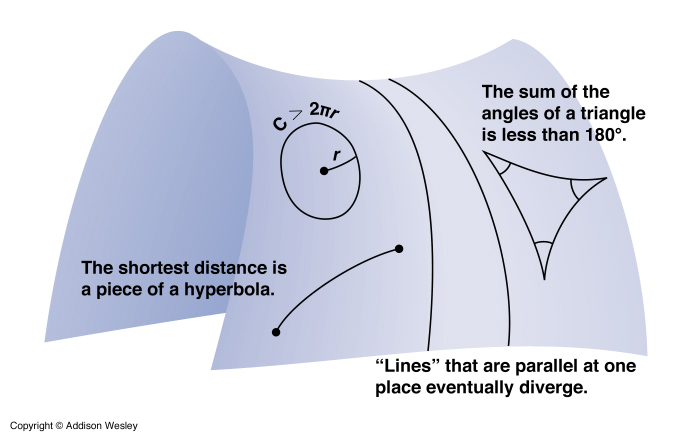
If space can be curved and geometry is different in differently curved spaces what does motion in a straight line mean?
It means taking the shortest path.
In a curved space that is going to be a curved line. In relativity that will be a line along which you feel no net forces. A force-free frame travels on a straight line.
A Freely-Floating frame is a force-free frame, and by the equivalence principle so is a Freely-Falling frame.
So if you are falling toward the Earth you are feeling no net forces as you are in freefall, and thus you are on the shortest path toward the center of the Earth. If you wish to get to the other side of the Earth (say from some high poing way up in orbit) the shortest path would not be through the center of the Earth. (Once you pass the center of the Earth you feel a net force back toward the Earth). The shortest path is along the orbit (which also has no net forces acting on it because gravitaional acceleration and centripetal acceleration balance each other).
If we could draw what this situation looks like we could imagine that the 4-Dimensions of spacetime are compressed into a 2-D rubber sheet. An object is placed within the sheet and warps its shape. The curvature of the sheet would then be into the 3rd dimension. And we can see how the orbit would be a shorter path.
We call this an Embedding Diagram.
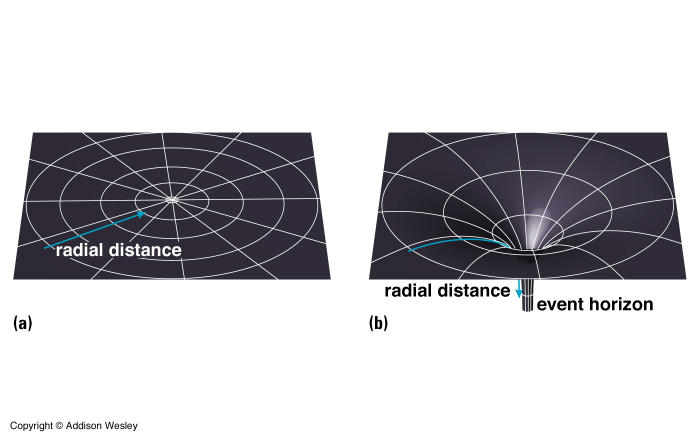
Gravity
From gravity's behavior we can draw embedding diagrams about a gravitating object and can describe the force of gravity as a curvature of spacetime. This is fundamentally different from the Standard Model of Quantum Mechanics which uses classical forces transmitted via Bosons. Gravity is no longer a force but the result of the presence of mass.
The strength of Gravity depends upon the amount of spacetime curvature. The amount of spacetime curvature depends on the amount of mass/energy present within.
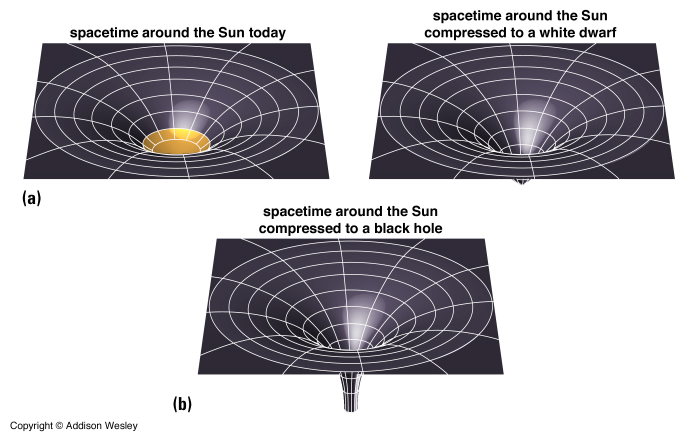
Orbits are the result of objects passing through curved spacetime.
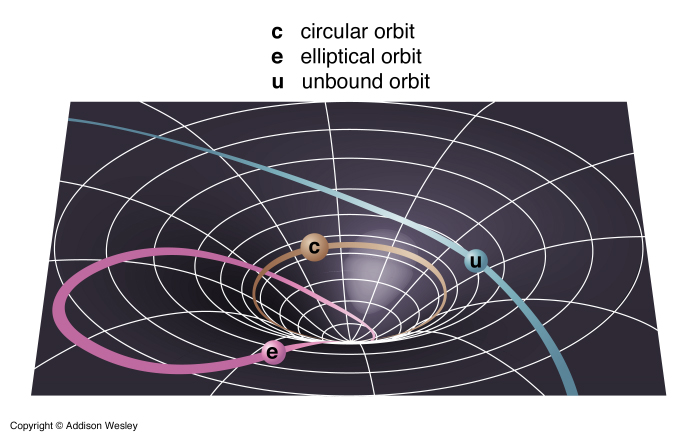
We can explain the the descrepency between the amount of precession of Mercury's orbit and the amount predicted by Newton's laws. Newton's laws assume the distance around the Sun at a given radius will behave as in plane geometry and hence overestimate the length of the orbit.

General Relativity predicts the precise amount of precession that is actually observed.
Gravitational Time Dilation
Because different observers trapped within 4-D spacetime are doomed to view only projections of it we are bound to find more strange effects from General Relativity as we did with Special Relativity.
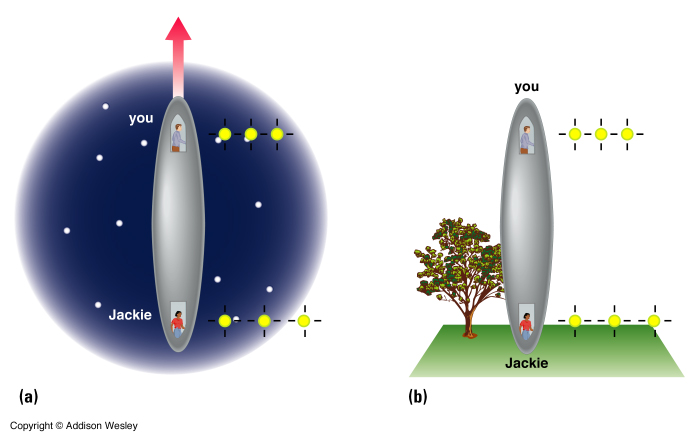 Imagine You and Jackie are in a stretch-limo spaceship. You are in the front and Jackie is in the back.
Imagine You and Jackie are in a stretch-limo spaceship. You are in the front and Jackie is in the back.
Each of you has a flashing watch perfectly synchronized. The spaceship begins accelerating.
As the ship accelerates You will be carried away from Jackie's flashes and so they are stretched out in time. Thus You see her time to run slower than your own.
Likewise, Jackie is being carried into Your flashes making your time seem to run faster than her own.
Since acceleration is equivalent to gravity we can imagine the same situation with the long ship on Earth. At higher altitudes time runs faster than at lower ones.
Thus, time runs slower in a stronger gravitational field!
|
Gravitational Lensing
Light must be seen to travel at the same speed for all observers. It can never be seen to accelerate. Therefore, it must travel force-free paths. In other words, it must always travel along straight lines through whatever kind of space it is traversing.
This will mean that light will appear to travel curved paths around massive objects. This is called Gravitational Lensing.
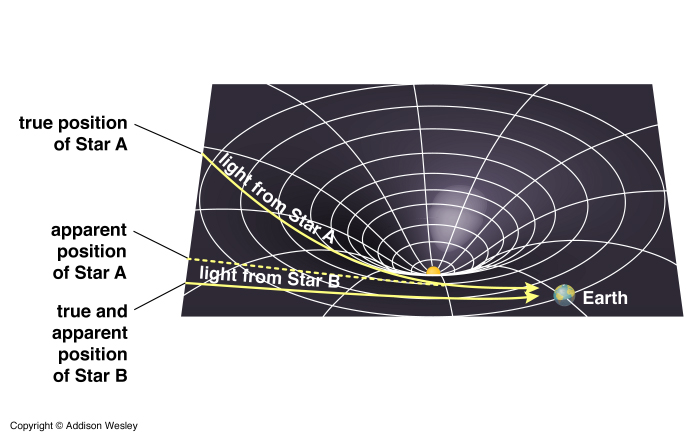
The image of an object will appear deflected by the gravity of the foreground object. This can lead to multiple images and even rings if the geometry of the situation is just right.
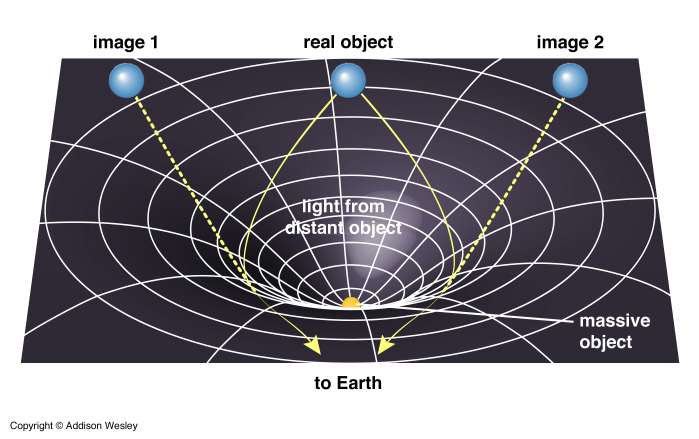
This has been observed numerous times and is now used to search for different forms of Dark Matter.


Gravitational Redshift
Because time runs slower near a gravitating object than it does far away from it the frequency of light escaping a gravitational well will be time-dilated.
This leads to light's frequency appearing to become lower as it escapes the gravity of an object. Hence the light appears more red and this becomes a 2nd kind of redshift: Gravitational Redshift.
Note that because the light is moving toward lower frequency (and hence longer wavelengths) it is also redshifted to lower energy:
E = hf
One can alternatively think of gravitational redshift arising from the light losing energy as it climbs out of the gravitational field (similar to the way a rocket loses kinetic energy to potential energy).
Gravitational Waves
Similar to how the motion of electrical charges generate waves in magnetic and electric fields, so too would it be with the gravitational field predicted by General Relativity. These waves would travel at the speed of light and be alternating compressions and rarefactions of spacetime.
Gravitational waves have as yet never been detected, because the effect they cause is very small, and the method of detection very tricky. Detectors are currently being built and hope to see gravitaional waves coming from systems that are predicted to put out tons of waves.
Some systems are binary neutron stars in close orbit. Spacetime is warped severly about a neutron star and in a system such as this strong gravity waves are expected.
The waves carry orbital energy away from the system and would cause the binary orbit to decay to smaller and smaller sizes. By Kepler's 3rd law recall that this means a faster orbital period.
One such system: The Hulse-Taylor binary neutron star system. The decay of the orbit is observed to decrease the period precisely by the amount General Relativity predicts.
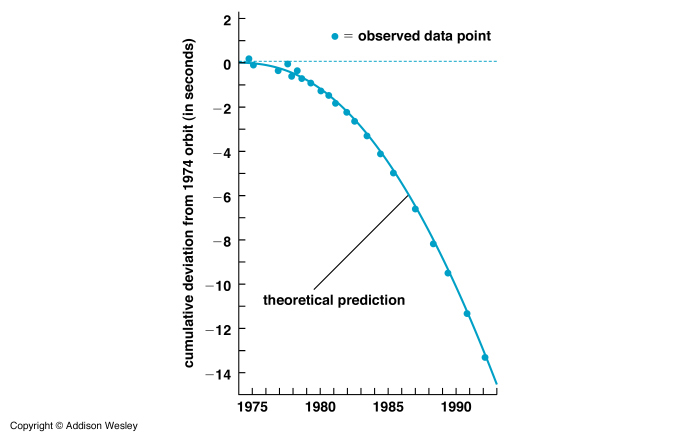
Black Holes
General Relativity also predicts the existence of Black Holes. In General Relativity a Black Hole would be an object so dense that light leaving straight away from its surface would be gravitationally redshifted infinitely. In other words, light cannot escape from a black hole.
If light cannot escape a black hole, then nothing can.
The radius at which light cannot escape from is called the Schwarzchild radius:
RS = 2GM/c2
The more massive the object the larger the radius. To make an object a black hole you must squish all its matter inside this radius. The collapsing cores of massive stars may be crushed beneath their Schwarzchild radii when neutron degeneracy pressure fails to support them against gravity.
This surface at this radius is called the Event Horizon. It is called this because beyond this surface all events must be forever unknown.
Imagine a journey into a black hole as seen by two observers: You and Jackie
- First let's imagine you are far away from a black hole and watching Jackie decend into it. She has with her a flashing watch similar to the one before. As she approaches the black hole you will notice:
- The light from her watch will become redshifted.
- The period of the flashes will get longer.
Time seems to slow down for her relative to you. If she stopped her decent and returned to meet you, you would find that she has experienced less time than you. The closer she is to the Event Horizon and the longer she spends there the larger the time difference would be.

If she now heads back toward the Event Horizon with the intention of crossing over, you will never see her cross over. The closer she gets to the Horizon the slower her time seems to run and the more redshifted her light (hence the larger the telescope you will need). At the event horizon time is frozen. Eventually, you will either get bored and leave or die while waiting to see her cross.
- From Jackie's point of view everything in her frame is normal. She will however see light from your light-watch blueshift and the period of their flashes increase. She sees your time speed up! Crossing the event horizon would be no big deal for her, she just crosses it with little fanfare. However, before crossing she would witness the entire future history of the Universe unfold before her!
She had better watch out, however! Tidal forces (the differential pull of gravity) would be so great over the length of her body that she will be stretched into a string. He feet are feel a much stronger gravity than her head.
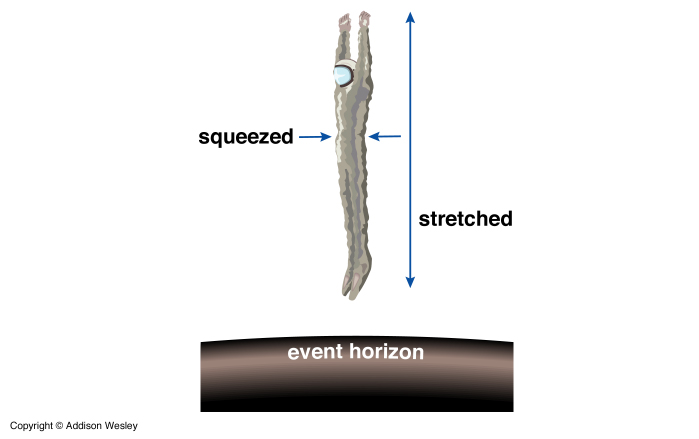
The effect is weaker the bigger the black hole is. She would be okay if this were a supermassive black hole like those that live in the center of galaxies.
Once she is in that is it. We can predict based on General Relativity what the interior of a black hole might be like, but she can't come back out to tell us if it is true or not. Maybe there is a singularity at the center: a single point where all of the mass is concentrated. Pure Space may give way to pure time at certain points. There is just no way to know.
Worm Holes
Imagine taking a trip from Hawaii to South Africa. It's a long trip if you fly along the Earth's surface. But what if you tunneled directly through the Earth? You could shorten the trip considerably.
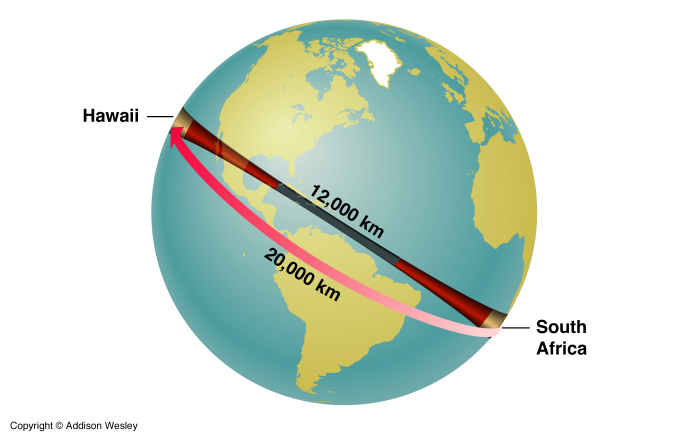
This is the idea behind a worm hole. It is a tunnel that connects two vastly different regions of spacetime via a short-cut through hyperspace.
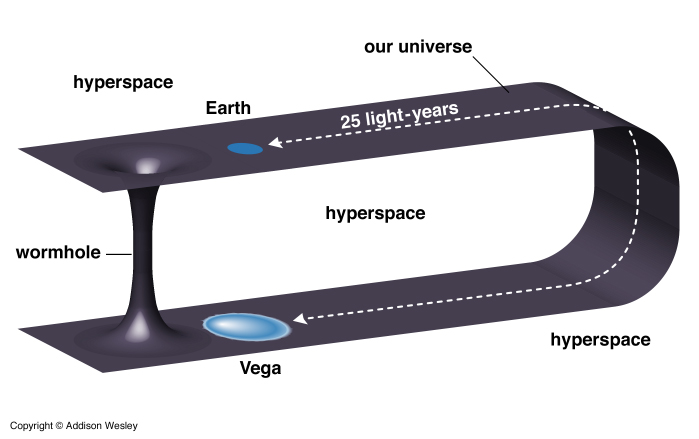
Worm holes are only predicted to be possible. They have never been observed and some suspect that there may be no natural way for them to form. They might however be possible to construct.
Using them for space travel would be tricky. Their extreme warping of spacetime leads to a wicked gravitational force that will be tough for spacetime travellers to handle. Also theory predicts that the tunnel would close off faster than even light could travel through it (turning both mouths in black holes). Some theorists have suggested that a special class of worm holes could be made to be traversable with the use of material that creates a negative pressure inside the Worm hole. They call this material exotic matter.
One reason that some scientists think that worm holes may not be allowed to exist by the Universe is that if they exist then time travel could be possible!
Time Travel
Imagine you have a worm hole out in space. The two mouths are separated by a short distance. They are initially at rest with respect to one another. If you were to move one mouth as speed approaching light with respect to the other mouth you could create a time difference between the two mouths. Travelling down one mouth and coming out the other could be a trip either forward or backward in time depending on the direction you went!
Yikes! What if you managed to go back in time and show up at the other mouth just before you entered it. Then you decide to stop yourself in the past from going in.
Uh Oh.... PARADOX!!!!!!!!!!!!!!!!
There are three ways out of the Paradox:
- Chronology Protection Conjecture: Put forth by Stephen Hawking. The Universe does not allow any time travel. Worm holes and all other closed timelines are impossible for some reason we have yet to uncover.
- Predestination. Time travel is possible, but one cannot change events that have already happened or will happen. The shape of spacetime already exists and cannot be changed.
- Parallel Universes. For every cause in the Universe there are parallel Universes created (existing in some higher dimension of universes: call it a macroverse) that have the entire spread of possible effects. The most probable effects generate the most parallel universes. We are always most likely to exist in a Universe with the most probable outcome. The past cannot be altered because in doing so we only create a new Universe which branches out from the original at the moment of time travel.
Want to read more? Check out a paper I wrote on the subject several years ago:
Time Travel
Return to Class Notes Page
 Imagine that You and Jackie are floating around in space and You suddenly fire your engines and produce an acceleration up at 9.8 m/s/s.
Imagine that You and Jackie are floating around in space and You suddenly fire your engines and produce an acceleration up at 9.8 m/s/s.
 Imagine that you are sitting in a closed room with the shades drawn. If your room was moved to outerspace and accelerated at a rate of 9.8 m/s/s you would not notice anything different.
Imagine that you are sitting in a closed room with the shades drawn. If your room was moved to outerspace and accelerated at a rate of 9.8 m/s/s you would not notice anything different.
 Return to You and Jackie. You think that you must be accelerating upward. But You could equivalently say that your ship is at rest on the Earth's surface, perched on a cliff say, and that is why you feel weight. The reason You see Jackie freely floating is that she is falling toward the Earth. She is in freefall just like space shuttle astronauts.
Return to You and Jackie. You think that you must be accelerating upward. But You could equivalently say that your ship is at rest on the Earth's surface, perched on a cliff say, and that is why you feel weight. The reason You see Jackie freely floating is that she is falling toward the Earth. She is in freefall just like space shuttle astronauts.








 Imagine You and Jackie are in a stretch-limo spaceship. You are in the front and Jackie is in the back.
Imagine You and Jackie are in a stretch-limo spaceship. You are in the front and Jackie is in the back.








